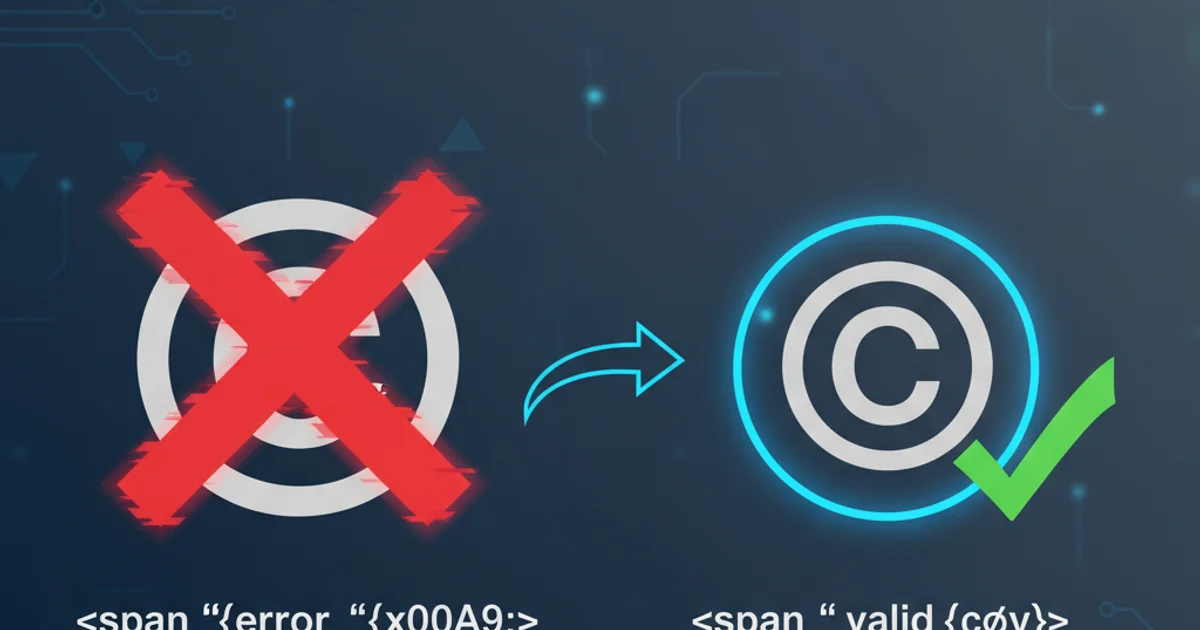Copyright symbol "©" is invalid?
Categories:
Resolving Invalid Copyright Symbol Errors in HTML and Eclipse

Encountering 'invalid character' errors for the copyright symbol (©) in HTML, especially within IDEs like Eclipse, can be frustrating. This article explains common causes and provides robust solutions to ensure your copyright notices display correctly.
The copyright symbol, represented by the HTML entity © or its numeric equivalents © and ©, is a fundamental part of web content. However, developers often face issues where these seemingly standard entities are flagged as 'invalid characters' by their development environments or browsers. This typically stems from character encoding mismatches or incorrect usage. Understanding the root cause is key to a permanent fix.
Understanding Character Encoding and HTML Entities
Character encoding defines how characters are stored and displayed. The most common encoding for web pages today is UTF-8, which supports a vast range of characters, including the copyright symbol. Older encodings like ISO-8859-1 (Latin-1) also support it, but problems arise when there's a discrepancy between the encoding declared in your HTML, the encoding of the file itself, and the encoding expected by your IDE or browser.
flowchart TD
A[HTML File] --> B{Declared Encoding?}
B -- Yes --> C{File Encoding Match?}
B -- No --> D[Encoding Mismatch Error]
C -- Yes --> E[Browser/IDE Renders Correctly]
C -- No --> D
D --> F[Invalid Character Display]Flowchart illustrating character encoding validation process.
HTML entities like © are designed to represent special characters that might otherwise be misinterpreted by the browser or conflict with HTML syntax. They are encoding-agnostic in the sense that the browser is supposed to interpret the entity itself, regardless of the file's encoding, and then render the corresponding character. However, if the entity itself is malformed or if the environment is configured to be overly strict, it can still lead to errors.
Common Causes of 'Invalid Character' Errors
Several factors can lead to the copyright symbol being flagged as invalid:
- Incorrect HTML Entity Usage: While
©is a valid hexadecimal entity,©is generally preferred for readability and broader compatibility. Sometimes, typos or incorrect syntax (e.g., missing semicolon) can cause issues. - File Encoding Mismatch: Your HTML file might be saved with one encoding (e.g., UTF-8), but your HTML document declares a different one (e.g., ISO-8859-1) in the
<meta charset="...">tag. Or, your IDE (like Eclipse) might be interpreting the file with a different default encoding. - IDE Configuration (Eclipse Specific): Eclipse has its own workspace and project-level text file encoding settings. If these don't align with your HTML file's actual encoding or the declared encoding, it can flag valid characters as errors.
- Copy-Pasting Issues: Copying content from external sources (e.g., Word documents) can sometimes introduce 'smart quotes' or other non-standard characters that look like a copyright symbol but are not the correct HTML entity or Unicode character.
<!DOCTYPE html>
<html lang="en">
<head>
<meta charset="UTF-8">
<title>Copyright Example</title>
</head>
<body>
<footer>
<p>© 2023 My Company. All rights reserved.</p>
<p>Using numeric entity: © 2023</p>
<p>Using hexadecimal entity: © 2023</p>
</footer>
</body>
</html>
Correct usage of copyright entities in HTML with UTF-8 declaration.
<head> section of your HTML document using <meta charset="UTF-8">. This is the most widely supported and recommended encoding for modern web development.Resolving the 'Invalid Character' Error in Eclipse
When Eclipse flags © or © as invalid, it's usually an encoding issue within the IDE itself. Here's how to address it:
1. Check Project/File Encoding
Right-click on your project or the specific HTML file in Eclipse's Package Explorer. Go to 'Properties' -> 'Resource'. Ensure the 'Text file encoding' is set to 'UTF-8'. If it's different, change it to UTF-8 and apply the changes. You might need to clean and rebuild your project.
2. Verify Workspace Encoding
Go to 'Window' -> 'Preferences' -> 'General' -> 'Workspace'. Ensure 'Text file encoding' is set to 'UTF-8'. While project-specific settings override workspace settings, it's good practice to have a consistent default.
3. Confirm HTML Meta Charset
Double-check that your HTML file explicitly declares <meta charset="UTF-8"> within the <head> section. This tells the browser how to interpret the document.
4. Use Standard HTML Entities
Prefer © over numeric or hexadecimal entities for the copyright symbol, as it's more readable and less prone to subtle parsing issues, although all are technically valid.
5. Clean and Rebuild Project
After making encoding changes, sometimes Eclipse needs a refresh. Go to 'Project' -> 'Clean...' and select your project. Then, 'Project' -> 'Build Project' (if auto-build is off).
By systematically checking and aligning your file encoding, HTML document declaration, and IDE settings, you can resolve most 'invalid character' errors related to the copyright symbol and ensure your web content displays as intended across different environments.